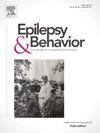Steps towards seizure freedom with the use of Cenobamate
IF 2.3
3区 医学
Q2 BEHAVIORAL SCIENCES
引用次数: 0
Abstract
Background and purpose
Cenobamate (CNB) is an antiseizure medication (ASM) that may change the prescription across the time. Our study sought to compare the rate of seizure-freedom patients after one year of CNB use experience in a single tertiary centre.
Methods
All patients with a minimum follow-up of one year who used CNB between 2021 and 2022 (n = 66) were compared to those who treated during 2023 (n = 126).
Results
In 2023, patients were older, used fewer concomitant ASMs (IQR 2–3 in 2023 vs 3–4 in 2022), and had a lower seizure frequency. Seizure-freedom rates at 12 months in 2021–2022 cohort were 16.7 %, and 23 % in 2023. The responder rate was greater than 60 % in both cohorts. The CNB titration was slower in the 2023 cohort, the median dose achieved was 225 mg in 2021–2022 and 200 mg in 2023. Concomitant ASMs were reduced in 70 % for both groups. The adverse event rate was nearly 60 %, most of them central nervous system-related. The CNB retention rate at 12 months was over 80 % in both groups. In 2023, up to 12 % of patients remained in monotherapy after 12 months.
Conclusions
This is the first real-world data series that compares the use of CNB in two cohorts of a single centre. One year follow-up seizure freedom rates above 20% can be achieved by a proper patient selection, CNB dose increase and ASM dose reduction, which eventually lead to CNB monotherapy in some cases.
使用Cenobamate实现癫痫发作自由的步骤
背景与目的塞诺奥巴酸(CNB)是一种抗癫痫药物(ASM),可能随着时间的推移而改变处方。我们的研究试图比较在单一三级医疗中心使用CNB一年后癫痫发作不受影响的患者的比率。方法将所有在2021年至2022年期间接受CNB治疗的患者(n = 66)与在2023年期间接受CNB治疗的患者(n = 126)进行比较。结果2023年患者年龄较大,同时使用抗痉挛药物较少(2023年IQR为2-3,2022年为3-4),发作频率较低。2021-2022年队列12个月癫痫自由率为16.7%,2023年为23%。两个队列的应答率均大于60%。在2023年队列中,CNB滴入速度较慢,2021-2022年达到的中位剂量为225 mg, 2023年为200 mg。两组同时发生的asm均减少70%。不良事件发生率近60%,主要与中枢神经系统有关。两组12个月时CNB保留率均超过80%。2023年,高达12%的患者在12个月后仍在接受单药治疗。这是第一个真实世界的数据系列,比较了在一个中心的两个队列中CNB的使用。通过适当的患者选择,增加CNB剂量和减少ASM剂量,可以实现一年随访中20%以上的癫痫发作自由率,最终导致部分病例采用CNB单药治疗。
本文章由计算机程序翻译,如有差异,请以英文原文为准。
求助全文
约1分钟内获得全文
求助全文
来源期刊

Epilepsy & Behavior
医学-行为科学
CiteScore
5.40
自引率
15.40%
发文量
385
审稿时长
43 days
期刊介绍:
Epilepsy & Behavior is the fastest-growing international journal uniquely devoted to the rapid dissemination of the most current information available on the behavioral aspects of seizures and epilepsy.
Epilepsy & Behavior presents original peer-reviewed articles based on laboratory and clinical research. Topics are drawn from a variety of fields, including clinical neurology, neurosurgery, neuropsychiatry, neuropsychology, neurophysiology, neuropharmacology, and neuroimaging.
From September 2012 Epilepsy & Behavior stopped accepting Case Reports for publication in the journal. From this date authors who submit to Epilepsy & Behavior will be offered a transfer or asked to resubmit their Case Reports to its new sister journal, Epilepsy & Behavior Case Reports.
 求助内容:
求助内容: 应助结果提醒方式:
应助结果提醒方式:


